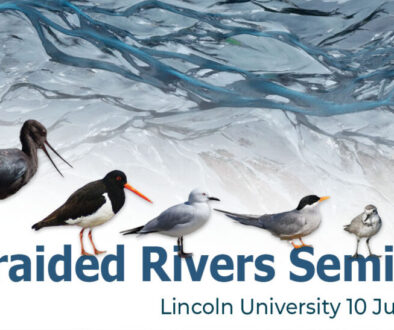Newsletter #75
Tēnā koutou,
Firstly, good news. Our application to Environment Canterbury’s Waitaha Action to Impact Fund has been successful. Amongst other things, this will allow us to hold another braided rivers seminar in July 2023. I have yet to finalise a date, but if you would like to present at this seminar, please get in contact as soon as possible so that we can begin developing a programme.
Last week, I attended the Rivers Group conference in Lower Hutt. The theme, ‘Making Room for Rivers’ was an opportunity to delve into the murky waters (no pun intended) of managing rivers. A big thank you to the organisers for a fantastic line up of speakers. Thanks also for inviting Grant Davey to present a poster on the status of braided river birds on the Rakahuri and Orari Rivers. And also the opportunity for me to speak on the topic of ‘Mixed messages: a braided rivers community engagement problem’.
Every speaker brought a wealth of experience, knowledge, and diverse world views. The message that stood out for me was simple. The European view of rivers imported to Aotearoa did not regard them as life-giving ancestors, but as beasts to be shackled, subjugated and exploited until they become zombie rivers. And we’re still squabbling over the remains. After more than a century of this behaviour, we must now, as Gerrard Albert said during his presentation, decolonise them, and in so doing, restore their mauri and their mana, which will also enable them to support their rich and unique biodiversity including braided river bird species.“Entries for our Conservation Awards 2022 are amazing in terms of the conservation work that is being done across Canterbury for our natural environment, mostly by volunteers. It is challenging to pick finalists from the array of inspiring entries. The dedication, energy and outcomes of these community and school groups is to be acknowledged and celebrated by all of us. Your presence would endorse that support and encouragement.
“Please join us at 7pm on Tuesday 22 November for the Awards Evening at Aldersgate Centre, 309 Durham St North, Central Christchurch (Parking off Chester St W).
“Networking and light supper to follow. RSVPs to cacbnz@gmail.com would be helpful for catering.”
News
- Calling for volunteers to update Wikipedia! Anyone keen to do some wiki updating? This is seriously in need of a bit of updating: https://en.wikipedia.org/wiki/Black-fronted_tern
A couple lines from Frances Schmechel below to inspire someone!
Fieldwork on the Wairau River in Marlbrorough showed that the swamp harrier (Circus approximans) is a common raider of black-fronted tern nests for eggs, with the native kelp gull (Larus dominicanus) and South Island oystercatchers (Haematopus finschi) also raiding. Introduced mammals such as the cat (Felis catus), stoat (Mustela erminea), hedgehog (Erinaceus europaeus occidentalis) and black rat (Rattus rattus) have also been recorded.[11]
This is all there is under ‘conservation’ Numbers of black-fronted terns are decreasing across its range, and the species is classified as endangered. Threats include several species introduced to New Zealand – stoats (Mustela spp.), feral cats, the brown rat (Rattus norvegicus), hedgehog, dog, and from Australia, the common brushtail possum (Trichosurus vulpecula), and Australian magpie (Gymnorhina tibicen).[10]
- Wildlife populations plunge 69% since 1970: WWF (Carbon Brief…not that this is exactly ‘news’)
Reports and research
- 2022: Bell & McCool; Rakaia River Black-fronted tern monitoring 2021-2022, report for Boffa Miskell.
- 2022: Rickett et al; Trials with non-toxic baits for stoats and feral cats, New Zealand Ecological Society
- 2022: Armarego-Marriott, Future biological control, Nature Climate Change 12, p964,
- 2022: Jørgensen et al, Extreme escalation of heat failure rates in ectotherms with global warming, Nature 611, pp 93–98 (As braided rivers birds feed on insects—many of of which are ectotherms—and fish, the implications are not good.)
- 2022: Navalon et al; Environmental signal in the evolutionary diversification of bird skeletons, Nature 611, pp 306–311
- 2022: Falk et al: Intersexual social dominance mimicry drives female hummingbird polymorphism, Proceedings of the Royal Society B (I know we don’t hummingbirds in Aoteaora, but this is a fascinating piece of research. I wonder if it applies to other birds species…)




